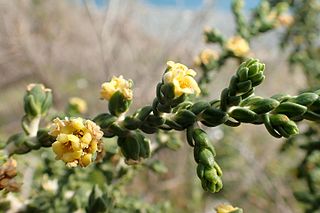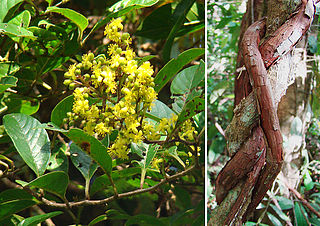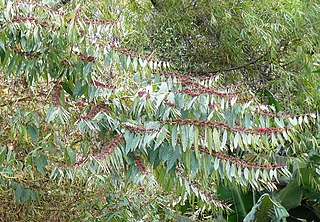
The Canellaceae are a family of flowering plants in the order Canellales. The order includes only one other family, the Winteraceae. Canellaceae is native to the Afrotropical and Neotropical realms. They are small to medium trees, rarely shrubs, evergreen and aromatic. The flowers and fruit are often red.

The Thymelaeaceae are a cosmopolitan family of flowering plants composed of 50 genera and 898 species. It was established in 1789 by Antoine Laurent de Jussieu. The Thymelaeaceae are mostly trees and shrubs, with a few vines and herbaceous plants.

Peridiscaceae is a family of flowering plants in the order Saxifragales. Four genera comprise this family: Medusandra, Soyauxia, Peridiscus, and Whittonia., with a total of 12 known species. It has a disjunct distribution, with Peridiscus occurring in Venezuela and northern Brazil, Whittonia in Guyana, Medusandra in Cameroon, and Soyauxia in tropical West Africa. Whittonia is possibly extinct, being known from only one specimen collected below Kaieteur Falls in Guyana. In 2006, archeologists attempted to rediscover it, however, it proved unsuccessful.
Nicobariodendron is a genus in the family Celastraceae, with only one species, Nicobariodendron sleumeri, a tree with simple, alternately set, entire leaves, small flowers and single seed fleshy fruits. It is only known from the Nicobar Islands of India.
Zehnderia is a monotypic genus of flowering plants belonging to the family Podostemaceae. It only contains one known species, Zehnderia microgyna.
Viridivia is a monotypic genus of flowering plants belonging to the family Passifloraceae. It only contain one known species, Viridivia suberosa. It is also in the subfamily Passifloroideae and tribe Paropsieae.

Davilla is a genus of flowering plants belonging to the family Dilleniaceae. It has around 30 neotropical, species and is one of most diverse genera of lianas, vines, erect or scandent (climbing) shrubs.
Gibbsia is a genus of flowering plants belonging to the family Urticaceae.

Hewittia malabarica is a flowering plant in the monotypic genus HewittiaWight & Arn., belonging to the family Convolvulaceae and widespread throughout tropical Africa, Asia, and Polynesia. It is a climbing or prostrate perennial herb with slender stems and flowers that are pale yellow, cream, or white with a purple center, and large leaves that can be used as a cooked vegetable or used in folk medicine with the roots. The stems can be used to make ropes.

Hullsia is a genus of flowering plants in the family Asteraceae. It only contains one species, Hullsia argillicola.
Klossia is a monotypic genus of flowering plants in the family Rubiaceae. The genus contains only one species, Klossia montanaRidl..
Martinella is a genus of flowering plants belonging to the family Bignoniaceae. It is a genus of Neotropical lianas within the tribe Bignonieae.

Neogaya is a monotypic genus of flowering plants belonging to the family Apiaceae. It just contains one species, Neogaya simplex(L.) Meisn. It can be found in Europe, in the Alps, the western and southern Carpathians, also former Yugoslavia, Belarus and the European parts of Russia. It is also found in Asia, within Kazakhstan, China, and western Siberia.

Pehria is a monotypic genus of plant in family Lythraceae. It has one known synonym, GrisleaLoefl.. The genus just contains one known species, Pehria compacta(Rusby) Sprague
Philippiella is a monotypic genus of flowering plants belonging to the family Thymelaeaceae. It just contains one species, Philippiella patagonicaSpeg.

Scandia is a genus of flowering plants belonging to the family Apiaceae. It is also in tribe Aciphylleae, with plants, Gingidia Dawson and Lignocarpa Dawson, with all three genera being native to New Zealand. They are scrambling shrubs with white flowers.
Poortmannia is a genus of flowering plants belonging to the family Solanaceae. It is also in Solanoideae subfamily, tribe Solandreae Miers and also subtribe Juanulloinae. The genus has only one known species, Poortmannia speciosaDrake.
Resia is a genus of plants in the family Gesneriaceae. They are also in the Beslerieae tribe.
Schindleria is a genus of flowering plants in the family Petiveriaceae.
Schreiteria is a monotypic genus of flowering plants belonging to the family Montiaceae. It is represented by the single species of Schreiteria macrocarpa(Speg.) Carolin. It is native to north-western Argentina.








